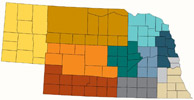Extension
Date of this Version
2-2023
Document Type
Article
Citation
Agronomy Journal (February 2023) 115(2): 526-543
doi: 10.1002/agj2.21247
Abstract
Cover crop growing periods in the western United States Corn Belt could be extended by planting earlier. We evaluated both pre-harvest broadcast interseeding and post-harvest drilling of the following cover crops: (a) cereal rye (Secale cereale L.) [RYE]; (b) a mix of rye + legumes + brassicas [MIX1], (c) a mix of rye + oat [Avena sativa L.] + legumes + brassicas (MIX2), (d) legumes [LEGU]) and (e) a no cover crop control. These were tested in continuous corn (Zea mays L.) [corn–corn] and soybean [Glycine max (L.) Merr.]–corn systems [soybean–corn] at three sites in Nebraska for their effect on cover crop productivity, soil nutrients, and subsequent corn performance. At the sites with wet fall weather, pre-harvest broadcasting increased cover crop biomass by 90%, to 1.29 Mg ha−1 for RYE and 0.87 Mg ha−1 for MIX1 in soybean–corn, and to 0.56 Mg ha−1 and 0.39 Mg ha−1 in corn–corn, respectively. At the drier site, post-harvest drilling increased biomass of RYE and MIX1 by 95% to 0.80 Mg ha−1 in soybean–corn. Biomass N uptake was highest in pre-harvest RYE and MIX1 at two sites in soybean–corn (35 kg ha−1). RYE and sometimes mixes reduced soil N, but effects on P, K, and soil organic C were inconsistent. In soybean–corn, corn yields decreased by 4% after RYE, and in corn–corn, by 4% after pre-harvest cover crops. Site-specific selection of cover crops and planting practices can increase their performance while minimizing impacts on corn.
Included in
Agricultural and Resource Economics Commons, Agricultural Education Commons, Food Science Commons, Rural Sociology Commons


Comments
Copyright 2023, the authors
License: This is an open access article under the terms of the Creative Commons Attribution License (CC BY)